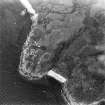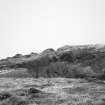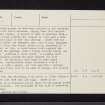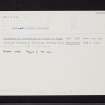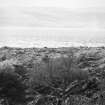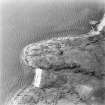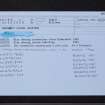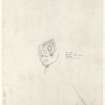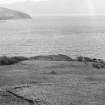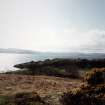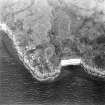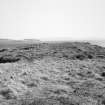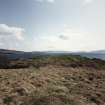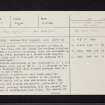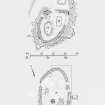Kilfinan, Macewan's Castle
Building (Post Medieval), Building (Medieval), Dun (Prehistoric), Coin (15th Century), Crucifix (12th Century)
Site Name Kilfinan, Macewan's Castle
Classification Building (Post Medieval), Building (Medieval), Dun (Prehistoric), Coin (15th Century), Crucifix (12th Century)
Alternative Name(s) Caisteal Mhic Eoghainn
Canmore ID 39861
Site Number NR97NW 1
NGR NR 9158 7955
Datum OSGB36 - NGR
Permalink http://canmore.org.uk/site/39861
- Council Argyll And Bute
- Parish Kilfinan
- Former Region Strathclyde
- Former District Argyll And Bute
- Former County Argyll
NR97NW 1 9158 7955.
(NR 9158 7955) Caisteal Mhic Eoghainn (NR) (Site of)
OS 6" map, Argyllshire, 2nd ed., (1900)
McEwan's Castle: Excavations carried out here in 1968-9 by the Cowal Archaeol Soc showed the earliest structure to have been a palisaded enclosure, which was succeeded by a promontory fort, enclosed by a timber-laced rampart, which was later used to form part of the defences of a medieval homestead.
The overall measurement of the structure is 70' x 90', with an annexe below and to the W. It is situated on top of a rocky headland from which blocked passages lead to the shore on the N and S.
Two series of post-holes were found under the medieval buildings; one set, similar to the palisade holes, were mostly cut in rock and natural soil. The others, much more solidly constructed, indicated a 30' diameter hut, probably contemporary with the rampart, in which traces of vitrification were found. The remains of earlier walls appear to have been adapted by the medieval occupants for their defences, edging them with massive rectangular stones. A carbon-14 test on charcoal from a post-hole found outside the rampart in 1968 gave a date in the first half of the 15th century. There were two buildings within the rampart, one, turf-walled, measured 35' x 21', while the other, stone-built, measured 24' x 21'. Also, in 1969, a round house built against the rampart at the gateway, with a firmly cobbled floor, was uncovered - possibly a store house. A roughly boat-shaped building outside the main rampart was also uncovered. No artifacts were found to date these structures. Unstratified finds included an 12th century crucifix (J G Scott 1993), a 15th century groat, and 13th and 18th century pottery sherds. All finds were to be sent to Glasgow Art Gallery and Museum.
Mrs Christian 1963; Cowal Archaeological Soc 1968; I Christian 1969.
An oval dun measuring 21.0m NE-SW by 17.6m within a wall up to 3.5m wide and 0.8m high. There is no indication of an entrance and no trace of the annexe noted by Mrs Christian. The remainder of the site is generally as described.
Revised at 1:10560.
Visited by OS (I A) 17 November 1972.
Field Visit (May 1985)
On a rocky promontory at the E end of Kilfinan Bay and 1.1km WSW of Fearnoch, there is a ruined dun known as Macewan's Castle or Caisteal Mhic Eoghainn. Excavations undertaken in 1968 and 1969 examined the dun wall in several places and revealed a series of internal buildings (Cowal Archaeol Soc 1968; Christian 1969), most of which are of medieval or later date and thus fall to be described in Volume 7 of RCAHMS Inventory (RCAHMS 1992); these features are shown in simplified form on the plan (RCAHMS 1988).
The dun measured about 22m by 20m within a stone wall 3m in thickness, but the N and NE flanks have been robbed to provide building-material for a series of later structures. Intermittent stretches of outer and inner facing-stones survive on the W and S. The entrance was probably situated in one of the gaps in the wall-debris on the N. On this side additional protection was afforded by an outer rampart or wall, which was drawn across the neck of the promontory some 14m to the N of the dun. Excavation revealed small lumps of vitrified material in many parts of the dun wall, and the excavators had the impression 'that the walls had been timber strengthened rather than timber laced'.
Two post-holes cut into the underlying rock or clayey subsoil (nos.1 and 2 on RCAHMS plan) have been interpreted as the remains of a free-standing palisade, but they are more likely to represent traces of timber framing within the original wall or else of refurbishment in the medieval period. Post-hole 23, which provided carbonised material for a radiocarbon determination of ad 1530 + - 70 (GaK -2046), measured 180mm in diameter and 100mm in depth and was packed with small stones. several post-holes (nos 3-8) found within the dun were 'small and slightly built', and most were cut into the natural clay subsoil or into rock. Larger and more substantially constructed post-holes formed a second group (nos 16-20) which may be part of a timber house at least 9m in diameter. Another clearly-defined post-hole was found a little to the NW. The occupation associated with the post-holes was represented by dark soil containing pieces of burnt clay, possibly daub. Finds included part of a pitchstone armlet, a fragment of lignite, and quartz and stone objects.
The later structures include the base of a turf-built wall, a well-built rectangular stone house, a circular stone building abutting the dun wall on the NE. Finds from the later periods include a crucifix of 12th-century date.
Visited May 1985
RCAHMS 1988
Measured Survey (20 May 1985)
RCAHMS surveyed Macewan's Castle dun on 20 May 1985 with plane-table and alidade producing a plan at a scale of 1:100. The plan of the dun was redrawn in ink and published at a scale of 1:250 (RCAHMS 1988a, 196).
Field Visit (May 1987)
On a rocky promontory at the N end of Kilfinan Bay and 1.1km WSW of Fearnoch, there is a ruined dun known as MacEwan's Castle or Caisteal Mhic Eoghainn. This site, like the motte at Ballimore, is associated with the MacEwans of Otter, a family of the same lineage as the MacSweens, Lamonts and MacLachlans. In 1432 their chief accepted a Campbell of Lochawe as heir to his barony of 'Ottirinwerane', and the family lost their status as landowners before the end of that century (1). Excavations undertaken in 1968 and 1969 revealed a series of medieval or later buildings. The earlier remains are described in volume 6 of this Inventory and in the published excavation report (2).
The prehistoric dun, which received additional protection from an outer rampart across the neck of the promontory 14m to the N, measured about 22m by 20m within a 3m drystone wall whose E and NE sectors have been robbed to provide material for the later buildings. The excavator identified refacing on the outer face of the sw sector, and carbonised material from a post-hole in this area (23) gave a radiocarbon determination of ad 1530 + 70 (GaK-2046), suggesting refurbishment of the rampart in the 15th or 16th century. The entrance was to the NW, and was blocked internally by a circular structure (C on fig.)
In addition to this building, there were excavated an oval turf-walled structure (A) in the S part of the enclosure, a rectangular stone-walled house (B) close to the demolished SE rampart, and a smaller stone building (D) 6m beyond the NE rampart. The turf structure measured 10m from NNE to SSW by 5.5m within a wall 0.9m thick in which several courses of turf could be identified. In the E wall there was an entrance about 2m wide, part of which was cobbled, and opposite it in the W wall there was an opening only about 0.5m wide. There was evidence for benches, of turf in the N end and of turf-and-stone against the wand possibly the E walls, and a central hearth with stone kerb in the S half of the building. A Romanesque crucifix was found above the wall of this building, and a groat of James I (1406-1437) was excavated above the floor-level, but there were no stratified finds (3).
The stone-walled house (B), whose associated cobbling overlay the E rampart, measured 7.4m from NNE to SSW by3.8m within 0.8m walls about 0.7m high; the inner angles at the N end were rounded, forming a curved end-wall. The 0.7m doorway, which was towards the S end of the E wall and contained several layers of paving and cobbling, had been deliberately blocked. There were stone benches against the end-walls, and a roughly cobbled floor with a hearth incorporating a 0.9m quern stone, one of several fragments re-used in this building. The circular building (C) measured about 4.3m in diameter within a 0.75m wall except at the N, where it incorporated the inner face of the disused rampart. Its entrance was to the NE and the floor was cobbled, but there was no evidence whether the structure was roofed, and there were no finds.
Building D, NE of the rampart, measured up to 6m from WNW to ESE by 3.1m within walls incorporating irregularly shaped boulders. There was an entrance in the N side-wall and remains of a blocked one in the curved E end-wall. A hearth was identified in a secondary phase overlying cobbling, and another hearth partly underlying the outer face of the N wall belonged to an earlier period of occupation non the site.
In addition to the crucifix and groat mentioned above, several sherds of green-glazed pottery of medieval type were excavated in and near the rampart, but there were no significant stratified finds in the buildings. While the turf house, which occupies a favourable position within the rampart, may be of late medieval date, the other buildings are undateable, and may be of the post-medieval period.
RCAHMS 1992, visited May 1987
(1) Scottish Studies, 15 (1971), 32-3; Origines Parochiales, 2, part 1, 54; AT, 24 June 1431, 20 March, 12 June 1432.
(2) RCAHMS 1988, No. 324; Marshall 1983.
(3) Marshall 1983, 138, pl. 1.
Measured Survey (20 May 1987)
RCAHMS surveyed MacEwan’s Castle on 20 May 1985 with plane-table and alidade producing a site plan at a scale of 1:400. The plan was redrawn in ink and published at a scale of 1:1000 alongside an excavation detail at a scale of 1:250 (RCAHMS 1992, 296).






















